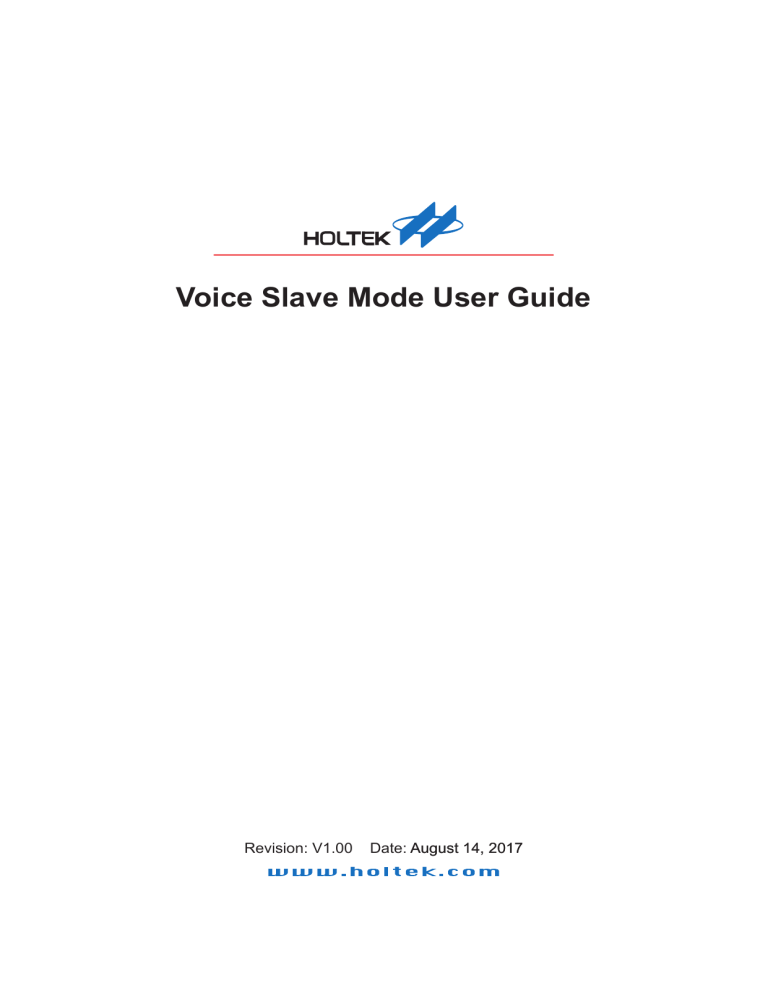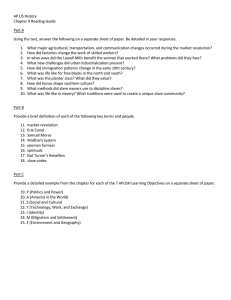
Voice Slave Mode User Guide Revision: V1.00 Date: ��������������� August 14, 2017 Voice Slave Mode User Guide Table of Contents 1 Quick Start................................................................................................................ 3 Voice Slave Mode Introduction............................................................................................... 3 Hardware and Software Development Environment............................................................... 3 Detailed Operating Steps........................................................................................................ 5 2 Application Circuit Description............................................................................ 11 Single-wire Communication Application Circuit Description................................................. 11 Single-wire Communication Application Circuit – 5V....................................................................... 12 Single-wire Communication Application Circuit – 3.3V.................................................................... 12 I2C Communication Application Circuit Description.............................................................. 13 I2C Communication Application Circuit – 5V.................................................................................... 14 I2C Communication Application Circuit – 3.3V................................................................................. 14 3 Communication Protocol Description................................................................. 15 Single-wire Communication Protocol Description................................................................. 15 I2C Communication Protocol Description.............................................................................. 16 Rev. 1.00 2 of 17 August 14, 2017 Table of Contents Hardware........................................................................................................................................... 3 Software............................................................................................................................................. 4 Voice Slave Mode User Guide 1 Quick Start Voice Slave Mode Introduction When using the voice slave mode of Holtek Voice MCU Workshop together with the HT66FV130/ HT66FV140 hardware circuits, the following functions can be implemented: ▀ A complete slave IDE3000 assembler project, which is used to play the voice, will be generated. Users can compile and download the voice playing project to the MCU directly using the IDE3000. 2 ▀ The master can send control commands to the voice slave according to the HOLTEK I C/singlewire protocol definition. Refer to “Communication Protocol Description” for details. It supports various features, such as up to 240 voice combinations, 13 volume levels as well as sleep and wakeup commands. Hardware and Software Development Environment Hardware ▀ PC with Windows XP or later version ▀ HOLTEK simulation tool – HT e-Link ▀ HT66FV130/HT66FV140 hardware circuit, refer to “Application Circuits” for details ▀ The connection diagram for programming the voice in-circuit into the SPI FLASH is as follows Rev. 1.00 3 of 17 August 14, 2017 Quick Start ▀ The user selected voice files can be programmed into the SPI Flash and combine multiple voice files to generate an appropriate voice. Voice Slave Mode User Guide Software Holtek Voice MCU Workshop V2.30 version or later versions (Click to download). Quick Start Rev. 1.00 4 of 17 August 14, 2017 Voice Slave Mode User Guide Detailed Operating Steps Step 1. After download and installation, double-click the icon to open the desktop. Quick Start Rev. 1.00 5 of 17 August 14, 2017 Voice Slave Mode User Guide Step 2. Click the “New Project” button to create a new project, then enter a project name and project path. Then select the fourth mode, the voice slave mode, and select the communication mode and IC type. Here the HT66FV140 I2C slave mode is selected as an example. Quick Start Rev. 1.00 6 of 17 August 14, 2017 Voice Slave Mode User Guide Step 3. Click the “OK” button to create the voice slave mode. All settings have a default setting. Clicking the upper right corner of the red block diagram can change the voice source. Users can also change other default voice sources. Quick Start Rev. 1.00 7 of 17 August 14, 2017 Voice Slave Mode User Guide Step 4. Click the left side “Finish” button to program the voice files into the SPI Flash. If users want to program the voice files into the SPI Flash using other means, then this can be implemented by using the voice “.dat” file which is generated by the Voice MCU Workshop. Quick Start Rev. 1.00 8 of 17 August 14, 2017 Voice Slave Mode User Guide Step 5. After the voice MCU Workshop has indicated that the voice has been programmed, click on the “open current project” icon to open the integrated HT66FV140 I2C slave HT-IDE3000 project folders. The project program can be implemented directly without any user modification. Quick Start Rev. 1.00 9 of 17 August 14, 2017 Voice Slave Mode User Guide Step 6. A: If the HT66VV130/HT66VV140 emulation device is used, users can click the “HT66FV140_ I2C.PJTX” to open the HT-IDE3000 project and then compile and download the program using the e-Link. Quick Start B: If the HT66FV130/HT66FV140 device is used, it needs to download the HT66FV140_I2C.MTP file for programming using the HOPE-3000. Rev. 1.00 10 of 17 August 14, 2017 Voice Slave Mode User Guide 2 Application Circuit Description Single-wire Communication Application Circuit Description ▀ The play busy status output on PA7 should be connected to the master play status input detection pin. ▀ The power and ground pins should be connected to ensure that the communication voltage levels are matched. Rev. 1.00 11 of 17 August 14, 2017 Application Circuit Description ▀ The HT66FV130/HT66FV140 device command receive pins are both located on PB2. This pin should be connected to the master command transmitter pin. Voice Slave Mode User Guide Single-wire Communication Application Circuit – 5V Application Circuit Description Single-wire Communication Application Circuit – 3.3V Rev. 1.00 12 of 17 August 14, 2017 Voice Slave Mode User Guide I2C Communication Application Circuit Description 2 2 ▀ The I C clock pin, SCL, is on PC1 and the I C data pin, SDA, is on PC2 and the play status output pin is on PC0. These pins should be connected to the master correctly. It is recommended that the I2C communication pins should be connected to a 10KΩ pull-high resistor. It should be noted that the communication level can only be 3.3V. ▀ The power and ground pins should be connected to ensure that the communication voltage levels are matched. Rev. 1.00 13 of 17 August 14, 2017 Application Circuit Description 2 ▀ At the present time the I C communication only supports the HT66FV140 when used as a slave. It does not support the HT66FV130. Voice Slave Mode User Guide I2C Communication Application Circuit – 5V Application Circuit Description I2C Communication Application Circuit – 3.3V Rev. 1.00 14 of 17 August 14, 2017 Voice Slave Mode User Guide 3 Communication Protocol Description Single-wire Communication Protocol Description 0x01: Play the first voice source original file 0x02: Play the second voice source original file 0x03: Play the third voice source original file 0X00~0XDB: Set the play address …… 0xdb: Play the 219th voice source original file For example, sending 0x03 means to play the third combination voice in the Voice MCU Workshop “voice program “ 0xe0: Set the volume to 0 0xe1: Set the volume to 1 0xe0~0xec: Set the Volume 0xe2: Set the volume to 2 Level …… 0xec: Set the volume to 12 0xf2: Loop playing Loop playing the current voice 0xf4: Enter the SLEEP Mode The voice slave enters the SLEEP mode 0xfe: Stop playing Stop playing the current voice Single-wire communication the Addressed in the current project folder master program example Note: Waking up the voice slave does not require any special operations, each communication can wake up the voice slave, other data definitions are reserved. Rev. 1.00 15 of 17 August 14, 2017 Communication Protocol Description As shown in the accompanying figure, the master only needs to send a 1-byte command to the slave. The command definitions are as follows: Voice Slave Mode User Guide Single-wire communication data definition: Data 0: High level: Low level=1:3, the high level is held for 200μs and the low level is held for 600μs, as shown in the following diagram. I2C Communication Protocol Description On the basis of the standard I2C communication format, the master transmits the slave address (1byte) + play command 1 (1-byte) + play command 2 (1-byte) + XOR check value (1-byte) + test data (1-byte) to the slave. Slave address (7-bit address +1-bit read/write Currently defined as 0xf6 control) 1~0xf0: 1~240 voice play addresses 0xf2: Loop playing Play command 1 (8-bit) 0xf4: Enter the SLEEP Mode 0xfe: Stop playing Play command 2 (8-bit) 0x00~0x0c: Play volume level Others reserved XOR check value (8-bit) The XOR check value between play command 1 and play command 2 is sent to the slave to check whether the previous two data blocks have been received correctly Test data (8-bit) Used to test the data response from the slave. If the slave responds with a 0, this means that the play command, play command 2 and XOR check values have been received correctly. If the slave responds with a 1, this means that a reception error has occurred. The master will need to execute a new complete I2C communication with the slave to support the error retransmission mechanism Simulate I2C communication, the master program example In this example, the HT66FV160 device has been Addressed in the current project folder chosen as an example. Users can use the HOLTEK HT66FV1X0 development board for testing. Rev. 1.00 16 of 17 August 14, 2017 Communication Protocol Description Data 1: High level: low level=3:1, the high level is held for 600μs and the low level is held for 200μs, as shown in the following diagram. Voice Slave Mode User Guide Copyright© 2017 by HOLTEK SEMICONDUCTOR INC. The information appearing in this Data Sheet is believed to be accurate at the time of publication. However, Holtek assumes no responsibility arising from the use of the specifications described. The applications mentioned herein are used solely for the purpose of illustration and Holtek makes no warranty or representation that such applications will be suitable without further modification, nor recommends the use of its products for application that may present a risk to human life due to malfunction or otherwise. Holtek's products are not authorized for use as critical components in life support devices or systems. Holtek reserves the right to alter its products without prior notification. For the most up-to-date information, please visit our web site at http://www.holtek.com/en/. Rev. 1.00 17 of 17 August 14, 2017






